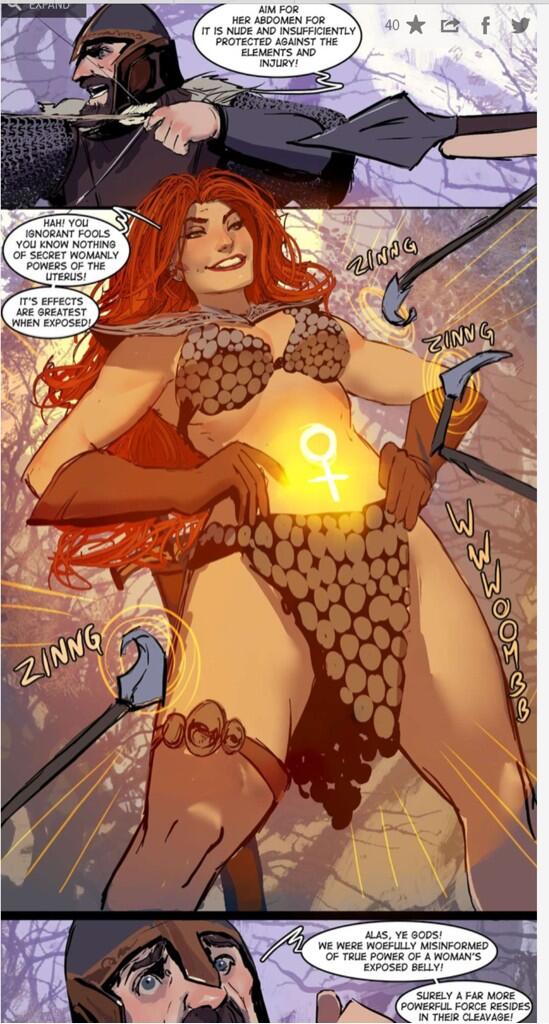One of the best Pathfinder characters I ever played was Fios, the fighter. She was raised by dwarves despite being human. Fios wielded a dwarven battle axe and she used it to tear through enemies like they were wet toilet paper. As she leveled, she got better and better armor and the last time I played her, I think she had full plate. In my head, I imagined her being pretty covered. After all, her vital organs needed to be protected. In fact, it was much to her disappointment that people couldn’t see all of her tattoos all of the time.
Anyone who has ever played a video game knows that not everyone shares my mental image of a female fighter. Artists may imagine Fios baring her stomach, going sleeveless, or wearing the dreaded chain mail bikini.
Having been raised in the good ol’ US of A, I believe in certain freedoms, and a choice to wear revealing, impossibly tight, or wildly impractical clothing is one of those rights. Likewise, it is the right of artists to draw women wearing silly armor because boobs = game sales or something. I see this on a lot of cover art in particular. Whether it be comic books or games, it seems like nearly every woman is showing off the goods. This isn’t a problem because we should be disgusted with the slightest expression of sexuality, but because it’s demeaning. Men on covers are often strong and powerful while, even when women are in a position of power, they are still a sex object.
The difference here is often shown most clearly in costume choice. Contrary to the enlarged mammaries we often see on female characters, male characters usually show off their large muscles and chiseled jaws covered with a manly stubble. This is usually done with spandex, full plate, or the absense of clothing, especially shirts. Is this sexualizing men? Sure it is. Is it a problem? Yeah, of course. All body types of men and women should be represented. Still, all of these tropes show that men are powerful. They are big, strong, and can take control of whatever they want. And, more often than not, their armor upgrades will cover them and protect them.
For characters who are young women, their femininity is on full display all the time. In these characters, you can clearly see tiny waists and large breasts all the time. Armor is reduced to a glorified bra and the limits of what lingerie tape can actually do is put to the test. Armor upgrades for this character often result in someone taking scissors to an already skimpy outfit and she is left with little more than a bathing suit to protect her from barrages of magic missiles and broadswords. Whenever I see art like this, I feel like it’s an extension of the artists putting this character in her place. She can fight and do cool stuff as long as we can stare at her boobs or her butt (preferably both) while she’s doing it. This is not a character with power.
Sometimes, people like to dress up like characters irl. Due to the abundance of characters in racy costumes, more often than not, there will be at least one cosplayer dressed as such at a convention. To me, cosplay is a way to show your appreciation of a work as a fan. I do it. A lot of my friends do it. However, this leads to many problems. The biggest one is that you can have the most accurate costume in the world, but, if you’re a woman, you might be interrogated and accused of being a “booth babe” by fellow fans and creators alike. A lot of my female friends have had this happen to them in and out of costume. None of my male friends have. This is due to the internalized misogyny present in the community. Not every male has this problem, obviously, but those who do are getting increasingly loud.
There isn’t one cause of it, but how women are portrayed in media certainly doesn’t help. We have seen over and over again with the “Fake Geek Girl” and, more recently Gamergate that there are fans who think that women are not welcome in gaming or other facets of geekdom, especially when those women are game developers or otherwise creating content. Honestly, I don’t think the occasional boobplate would be that big of a deal if there weren’t already so many problems in the community. I would be able to shrug it off, as, I think, would most people. However, it’s almost every female character on every cover. That’s where the problem because a disease and it’s infecting the community. What was once a community for people who really, really like something has become an exclusive club for people who were born a certain way. That’s not okay.
Read the “Game Like a Girl” original and part 2 here and here (or just look under out “Women in Gaming” category!).

